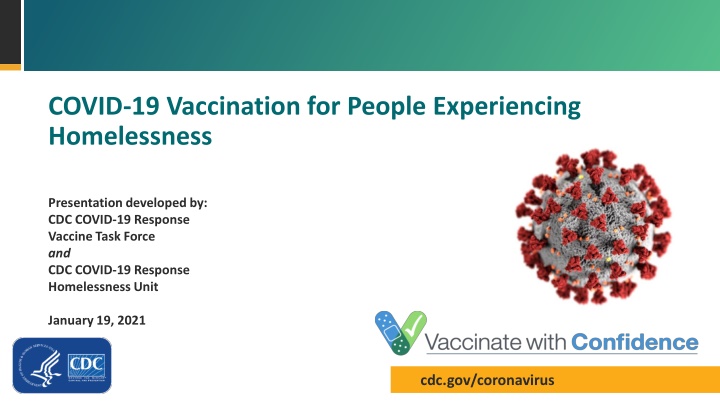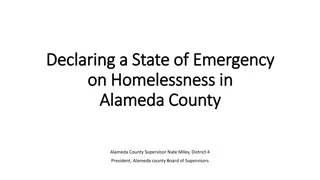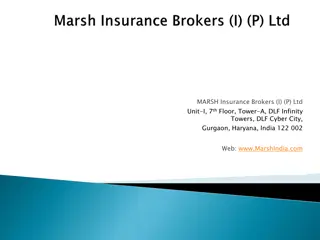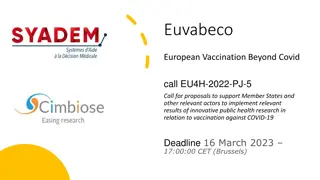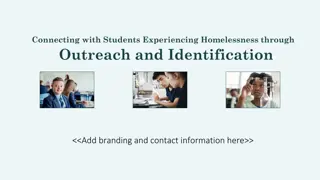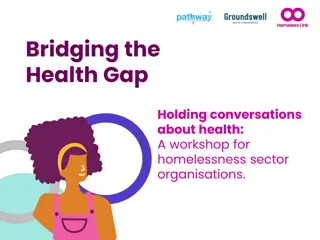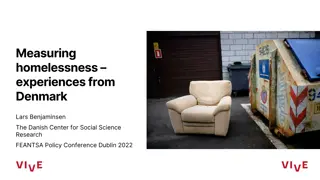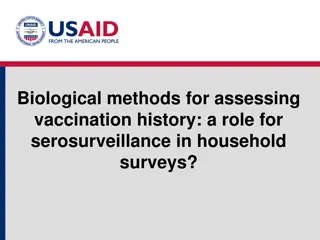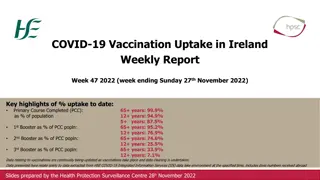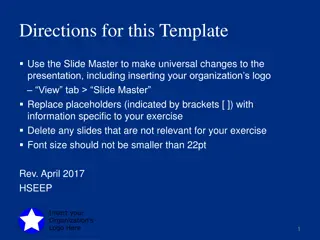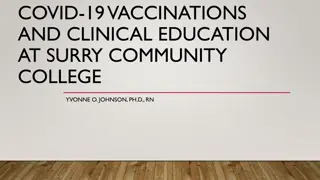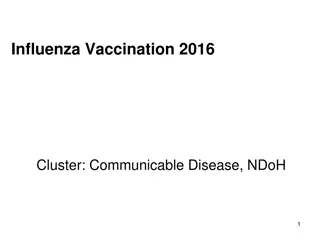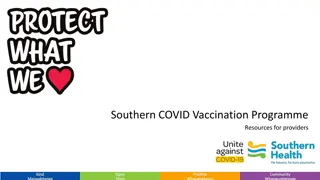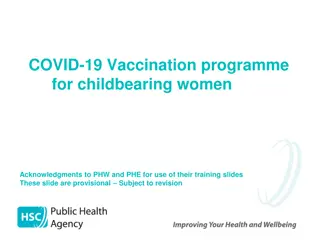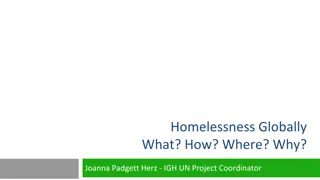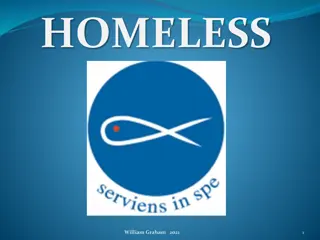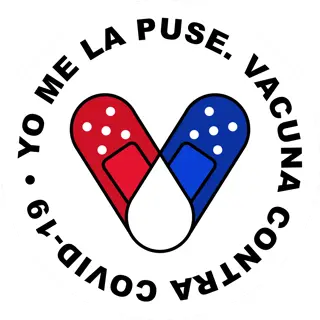COVID-19 Vaccination for People Experiencing Homelessness Presentation Overview
This presentation, developed by CDC's COVID-19 Response Vaccine Task Force and Homelessness Unit, focuses on COVID-19 vaccination basics, safety, prioritization for individuals experiencing homelessness, and strategies to overcome barriers to vaccination. It highlights the importance of understanding COVID-19, prevention measures, FDA's Emergency Use Authorization for vaccines, and statistics on vaccine trials. The material aims to educate on vaccine basics, vaccination strategies for the homeless population, and promoting confidence in vaccine uptake.
Download Presentation

Please find below an Image/Link to download the presentation.
The content on the website is provided AS IS for your information and personal use only. It may not be sold, licensed, or shared on other websites without obtaining consent from the author.If you encounter any issues during the download, it is possible that the publisher has removed the file from their server.
You are allowed to download the files provided on this website for personal or commercial use, subject to the condition that they are used lawfully. All files are the property of their respective owners.
The content on the website is provided AS IS for your information and personal use only. It may not be sold, licensed, or shared on other websites without obtaining consent from the author.
E N D
Presentation Transcript
COVID-19 Vaccination for People Experiencing Homelessness Presentation developed by: CDC COVID-19 Response Vaccine Task Force and CDC COVID-19 Response Homelessness Unit January 19, 2021 cdc.gov/coronavirus
Outline 1. 2. 3. COVID-19 vaccine basics COVID-19 vaccine safety Prioritization of people experiencing homelessness for COVID-19 vaccination Special considerations for vaccination among people experiencing homelessness 4. 2
Objectives Learn vaccine basics that you can share with your colleagues and people you serve. Identify vaccination strategies that can be used to reach people experiencing homelessness. Recognize how to help overcome barriers to COVID-19 vaccine confidence and receipt of the second dose. 3
What we know about COVID-19 Infection with SARS-CoV-2, the virus that causes COVID-19, can result in a range of illnesses, from mild symptoms to severe illness and death. We don t know how SARS-CoV-2 will affect each person. Some people are more likely than others to become severely ill, such as older adults (65+ years) or people with certain medical conditions.
How to prevent COVID-19 Wear a mask that covers your mouth and nose. Avoid close contact with others. Stay at least 6 feet (about 2 arms length) from other people. Avoid crowds. The more people you are in contact with, the more likely you are to be exposed to COVID-19. Avoid touching your eyes, nose, and mouth with unwashed hands. Clean and disinfect frequently touched surfaces daily. Wash hands often with soap and water. Use an alcohol-based hand sanitizer with at least 60% alcohol if soap and water are not available.
Adding new measures for prevention: COVID-19 vaccines FDA s Emergency Use Authorization (EUA) is a process that helps facilitate the availability and use of medicines and vaccines during public health emergencies, such as the current COVID-19 pandemic. Two vaccines have received an EUA (1/19/21): Pfizer-BioNTech (BNT162b2) Moderna (mRNA-1273) COVID-19 vaccines are being held to the same safety standards as all vaccines. Understanding Clinical Trials | NHBLI (nih.gov)
COVID-19 vaccine trials by the numbers As of November 30, 2020 Pfizer/BioNTech 43,931 enrolled 150 clinical sites 39 U.S. states Racial/ethnic distribution 13% - Hispanic 10% - African American/Black 6% - Asian 1%- Native American 45% ages 56-85 years Moderna 30,000 enrolled 89 clinical sites 32 U.S. states Racial/ethnic distribution 20% - Hispanic 10% - African American/Black 4% - Asian 3% - All others 64% ages 45 and older 39% ages 45-64 years 25% ages 65+ years Source: https://www.pfizer.com/science/coronavirus/vaccine; https://www.modernatx.com/cove-study For more information, visit www.clinicaltrials.gov
These COVID-19 vaccines are messenger ribonucleic acid (mRNA) vaccines. mRNA vaccines teach our cells how to make a harmless piece of the spike protein of the virus that causes COVID-19. The immune system recognizes the spike protein and triggers an immune response that is protective against the virus that causes COVID-19. mRNA vaccines do not use the live virus that causes COVID-19. They CANNOT give someone COVID-19. mRNA vaccines DO NOT affect or interact with our DNA in any way. Source: Understanding and Explaining mRNA COVID-19 Vaccines | CDC
COVID-19 vaccines are provided at no cost COVID-19 vaccine doses are purchased by the government and provided at no cost. Vaccination providers can charge an administration fee for giving the shot. Vaccine providers can get this fee reimbursed by the patient s public or private insurance company or, for uninsured patients, by the Health Resources and Services Administration s Provider Relief Fund. Providers must vaccinate patients even if they cannot be reimbursed. https://www.cdc.gov/vaccines/imz-managers/downloads/COVID-19-Vaccination-Program- Interim_Playbook.pdf 10
Vaccination is one measure to help stop the pandemic. The combination of getting vaccinated and following CDC recommendations to protect yourself and others offers the best protection from COVID-19. Cover your nose and mouth with a mask. Avoid close contact; maintain social distancing. Avoid crowds. Clean and disinfect. Wash your hands.
The facts: COVID-19 mRNA vaccines will not give you COVID-19. None of the COVID-19 vaccines in use or under development use the live virus that causes COVID-19. Side effects, such as fever, after vaccination are expected. These side effects are signs that the body is building immunity. It takes a few weeks for the body to build immunity after vaccination. A person could be infected with the virus that causes COVID-19 just before or just after vaccination and get sick. This is because the vaccine has not had enough time to provide protection.
The facts: COVID-19 mRNA vaccines will not cause you to test positive on COVID-19 viral tests. Vaccines currently authorized for use or in development won t cause you to test positive on viral tests, which are used to see if you have a current infection. There is a possibility you may test positive on some antibody tests, which show previous infection.
About these COVID-19 mRNA vaccines These mRNA vaccines are expected to cause side effects after vaccination, especially after the 2nd dose. Side effects may include: fever headache muscle aches No significant safety concerns were identified in the clinical trials. At least 8 weeks of safety data were gathered in the trials. It is unusual for side effects to appear more than 8 weeks after vaccination. Source: https://www.cdc.gov/vaccines/hcp/acip-recs/vacc-specific/covid-19/clinical-considerations.html
Ensuring safety while fast-tracking COVID-19 vaccines Investigators used existing networks to conduct COVID-19 vaccine trials. Manufacturing began while clinical trials are still underway. Normally, manufacturing doesn t begin until after completion of the trials. FDA and CDC are prioritizing review and authorization of COVID-19 vaccines. mRNA vaccines were developed quickly because they are faster to produce than most traditional vaccines. *For more information, visit the COVID-19 Prevention Network: www.coronaviruspreventionnetwork.org/about-covpn
Safety of COVID-19 vaccines is a top priority. COVID-19 vaccines are being held to the same safety standards as all vaccines. Before authorization FDA carefully reviews all safety data from clinical trials. ACIP reviews all safety data before recommending use. After vaccine authorization FDA and CDC closely monitor vaccine safety and side effects.
Active Safety Monitoring for COVID-19 Vaccines V-safe is a new CDC smart-phone based monitoring program for COVID-19 vaccine safety Uses text messaging and web surveys to check-in with vaccine recipients after vaccination Participants can report any side effects or health problems after COVID-19 vaccination Includes active telephone follow-up by CDC for reports of significant health impact If appropriate, a report will be entered into the Vaccine Adverse Event Reporting System (VAERS) 12/2/2020
What to expect before, during, and after COVID-19 vaccination Before Learn about COVID- 19 vaccines. See if COVID-19 vaccination is recommended for you. During Read the fact sheet that tells you about the specific COVID-19 vaccine you receive. Receive a vaccination record card. After Expect some side effects. Enroll in v-safe. Continue using all the measures to protect yourself. Make a plan to receive the 2nd dose (for vaccines requiring two doses)
Prioritization of People Experiencing Homelessness for COVID-19 Vaccination
COVID-19 among People Experiencing Homelessness Outbreaks of COVID-19 have been identified in homeless shelters across the United States Prevalence Ratio of SARS-CoV-2 infection among residents of a homeless shelter Chicago March-May 2020 (referent group) Ghinai I. Open Forum Infect Dis. 2020. doi: 10.1093/ofid/ofaa477.
COVID-19 among People Experiencing Homelessness PEH families w/children PEH adult families PEH single adults General population https://www.coalitionforthehomeless.org/age-adjusted-mortality-rate-for-sheltered-homeless-new-yorkers/
Phased approach to COVID-19 vaccine administration States have adopted different plans with phases of who will be prioritized to receive the vaccine first. Some states have included people experiencing homelessness in Phase 1. https://www.cdc.gov/vaccines/covid-19/phased-implementation.html
CDC considerations for congregate settings Staff and residents share an increased risk of disease. Jurisdictions may choose to vaccinate persons who reside at congregate living facilities (e.g., homeless shelters) at the same time as the frontline staff. https://www.cdc.gov/vaccines/covid-19/phased-implementation.html
Specific Considerations for COVID-19 Vaccination Among People Experiencing Homelessness
Vaccine implementation considerations Distribution Strategy Vaccine Confidence Estimating the number of people experiencing homelessness Second Dose Follow-Up How will we reach people for their 2nd dose? How will we reach people? How do we build trust in vaccination? How many vaccines are needed? 26
Estimate the population size for people experiencing homelessness Health Departments may need estimates of the number of people served by your organization. Further information needed might include: Sheltered vs unsheltered people Older vs younger adults 27
Point-in-Time counts The U.S. Department of Housing and Urban Development provides point-in-time (PIT) counts of people experiencing homelessness by Continuums of Care 1-night estimates of both sheltered and unsheltered homeless populations. 2019 PIT counts are currently available. Mapping the distribution of the population can help identify where vaccine distribution points are needed https://www.hud.gov/2019-point-in-time-estimates-of-homelessness-in-US 28
Vaccine distribution strategies Multiple vaccine distribution strategies are needed to reach everyone Frequently visited areas Healthcare facilities Homeless service sites Mobile units Pharmacies Bring vaccination to people experiencing homelessness Bring people experiencing homelessness to vaccination Images: https://thenounproject.com/
Vaccine distribution strategies Homeless service providers can support state and local health departments: Host on-site vaccination clinics Identify venues frequented by people experiencing homelessness Guide the development of tailored approaches to reach people you serve
Vaccine confidence Willingness to accept a vaccine falls on a continuum
Vaccine confidence Factors such as cautiousness, misinformation, and distrust of healthcare system may contribute to COVID-19 vaccine apprehension or hesitancy. Actions homeless service providers can take to improve vaccine confidence: Choose to get vaccinated yourself. Start conversations early. Engage in effective conversations. Be prepared to answer common questions Address misinformation by sharing key facts. Identify vaccine ambassadors: trusted people who can answer questions about COVID-19 vaccination and encourage their peers and network to get vaccinated.
Know the elements of effective vaccine conversations Start from a place of empathy and understanding. Give your strong recommendation. Address misinformation by sharing key facts. Connect people with trusted healthcare providers to answer questions I believe in this vaccine so strongly that I plan to get it as soon as I am able to. I strongly recommend you get a COVID-19 vaccine once it is widely available This shot is especially important for you because of your other conditions.
Second dose follow-up Actions homeless service providers can take to improve second dose follow-up: Request updated contact information and alternate ways to reach people. Support safe storage of vaccination cards. Everyone will receive vaccination cards with the date, type, and location of vaccination. Integrate second dose appointment reminders into routine interactions. Conduct targeted outreach to connect with individuals who could be lost to follow-up. https://www.cdc.gov/coronavirus/2019-ncov/community/homeless-shelters/vaccine-faqs.html
Continued COVID-19 precautions remain important Before, during, and after vaccine roll out, continue taking all precautions possible to prevent the transmission of the virus that causes COVID-19 including: Wearing masks Social distancing of at least 6 feet Avoid crowds. The more people you are in contact with, the more likely you are to be exposed to COVID-19. Washing hands with soap and water for at least 20 seconds or using hand sanitizer with greater than 60% alcohol content if soap and water are not available Facility layout, ventilation and procedure considerations https://www.cdc.gov/coronavirus/2019-ncov/community/homeless-shelters/plan-prepare-respond.html
Resources on the CDC website COVID-19 Vaccination General Information: https://www.cdc.gov/vaccines/covid-19/index.html Resources for COVID-19 and Homelessness: https://www.cdc.gov/coronavirus/2019-ncov/community/homeless-shelters/index.html COVID-19 Vaccination among People Experiencing Homelessness FAQs: https://www.cdc.gov/coronavirus/2019-ncov/community/homeless-shelters/vaccine-faqs.html Guidance for health departments conducting vaccine distribution among people experiencing homelessness: Coming soon
For more information, contact CDC 1-800-CDC-INFO (232-4636) TTY: 1-888-232-6348 www.cdc.gov The findings and conclusions in this report are those of the authors and do not necessarily represent the official position of the Centers for Disease Control and Prevention.
Vaccination Planning for People Experiencing Homelessness in Minnesota Blair Harrison, MPH Senior Advisor on Health, Homelessness and Housing | COVID-19 Homeless & Sheltered Response Lead Jennifer Zipprich, PhD District Epidemiologists Supervisor| COVID-19 Congregate Settings Branch Manager
Health Inequity Statement The Minnesota Department of Health acknowledges that structural inequities result in poor health outcomes across generations. These social, political, and environmental inequities have been exacerbated by the SARS-CoV-2 pandemic. To ensure equitable vaccine access, we commit to continuing to name systemic racism in health care, the ways in which individuals and families experiencing homelessness have been made to be vulnerable to COVID by the systems we work in every day, and the valid distrust in public health by many who live and work in homeless service settings and encampments.
5 Key Pieces of the Minnesota Response Governor s COVID-19 At-Risk Populations Work Group leading planning work Weekly engagement with Minnesota s homeless service providers and people impacted by homelessness Building on existing relationships through our testing work that are the foundation of our vaccine plan Senior Advisor on Health, Homelessness and Housing Position Strong Partnerships
Scope of Vaccination Activities 11 Tribal Nations -Urban Indian population 87 Counties - shelters - living settings included in our vaccine planning
Goal, Roles & Project Management Tribal partnership LPH partnership Unsheltered outreach DV planning Youth planning Survey Provider planning Communications Stakeholder Engagement & Planning Data & Evalation Administration & Logistics Project management Outcome measurement Evaluation Data systems transformation work Contracts Mapping/timelines Setting lists
Settings within the Scope of this Plan In Scope Out of Scope Isolation Hotels Doubled up Unsheltered Homeless, Outreach Teams, Drop-in Centers Scattered-site PSH Unlicensed sober homes Shelters (includes DV and youth) COVID hotel programs/sites Residential treatment facilities Site-based permanent supportive housing, transitional housing, board & lodge settings, and DOC-licensed halfway houses
Identifying Vaccine Providers Local Public Health Local Healthcare Systems Contracted providers 10/9/2024 44
Statewide Provider Contract Very strong working relationship with local healthcare system for testing Flu & Wellness Nurses statewide service area Could cover statewide need if necessary Will be working with the same manager who we ve partnered with on testing coordination This partnership is more than a contract- they are thought partners and problems solvers
Understanding Local Capacity Initial Planning Meetings Local public health departments with 20+ settings in their jurisdiction Outreach teams in areas with large unsheltered populations Email Survey Preference for covering settings Ongoing Engagement with Providers Statewide calls, 1-on-1 meetings
Tracking Access & Coverage Population- Level Person-Level Tracking Uptake
Thank you! Acknowledgments Contact us at: MDH Homeless Response Team & Congregate Settings Branch Blair.harrison@state.mn.us Minnesota Homeless State Action Team Jennifer.Zipprich@state.mn.us At-Risk Populations Work Group Local Public Health Partners Statewide Hennepin Healthcare, Health Care for the Homeless, and the Health, Homelessness, and Criminal Justice Research Lab Minnesota Community Care and Native American Community Clinic Minnesota s Homeless Service Providers & People Impacted by Homelessness
PEH are hospitalized at a much higher rate than all Minnesotans. COVID-Related Hospitalizations through January 21, 2021 48% % of cases hospitalized 22% 7% 5% 3% 1% Hospitalized ICU Unsheltered Sheltered MN Overall 49
